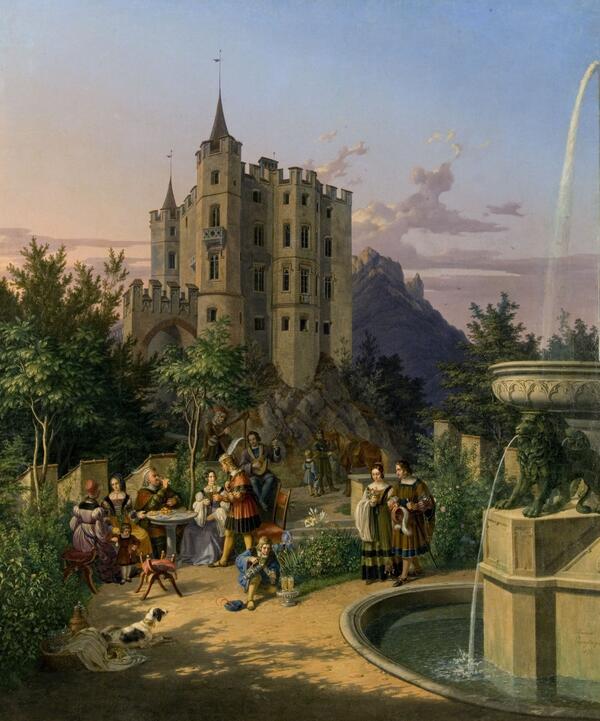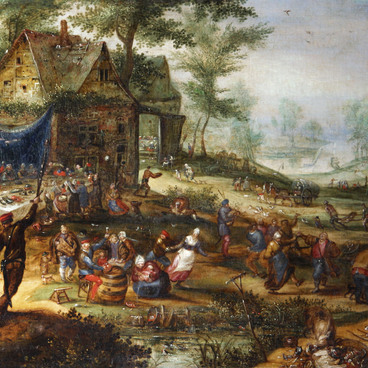“Hohenschwangau Castle”, the work of the German landscape painter and master of genre painting Lorenzo Quaglio Jr. (1793-1869), entered the Murom Museum in 1946. The legend says that two paintings were discovered by a soldier from Murom during the Great Patriotic War in Sherwood Castle (Hungary). They were rolled up in the attic, and probably would have been destroyed if they hadn’t been transferred to the museum and restored. The author of the painting was a representative of the famous dynasty of artists Quaglio. Since 1834, Lorenzo and his brother Domenico participated in the restoration of Hohenschwangau Castle.
This castle was originally built on the ruins of the Schwanstein fortress, the mention of which can be found in the historical chronicles of the XII century. According to one version, at first it was owned by the German princely family of the Welfs. Then the castle passed to the knights of the Schwangau family, to which the troubadour Gildbold von Schwangau, who lived at the beginning of the XIII century, belonged. The Heidelberg Songbook, a medieval German collection of secular poetry, tells about his adventures. In this castle Prince Konradin lived, the last representative of the Hohenstaufen family, the ruler of Bavaria. At the beginning of the XVI century, the priest Martin Luther, the founder of the Reformation, was hiding from persecution in the castle. According to legends, the famous Lohengrin — the swan knight, the hero of German folklore, to whom the “Swan Hall” of the castle is dedicated today, became famous in these places. In the XVI century, the line of the knights of Schwangau interrupted, and the castle was abandoned. In 1830, its ruins were acquired by Crown Prince Maximilian of Bavaria. The old fortress got a new life, and a new name — Hohenschwangau (literally the Swan District). Maximilian spent a fabulous sum of 7 thousand guilders for the restoration of the ancient structure at that time. Since 1836, the castle became the summer residence of the Bavarian kings. The symbol of the castle is snow–white swans, depicted everywhere: they decorate the facade, fountains in the garden, furniture and even dishes. These birds are now considered the hallmark of the castle. In the second half of the XIX century, Richard Wagner lived in the castle and wrote the opera “Lohengrin” here.
This castle was originally built on the ruins of the Schwanstein fortress, the mention of which can be found in the historical chronicles of the XII century. According to one version, at first it was owned by the German princely family of the Welfs. Then the castle passed to the knights of the Schwangau family, to which the troubadour Gildbold von Schwangau, who lived at the beginning of the XIII century, belonged. The Heidelberg Songbook, a medieval German collection of secular poetry, tells about his adventures. In this castle Prince Konradin lived, the last representative of the Hohenstaufen family, the ruler of Bavaria. At the beginning of the XVI century, the priest Martin Luther, the founder of the Reformation, was hiding from persecution in the castle. According to legends, the famous Lohengrin — the swan knight, the hero of German folklore, to whom the “Swan Hall” of the castle is dedicated today, became famous in these places. In the XVI century, the line of the knights of Schwangau interrupted, and the castle was abandoned. In 1830, its ruins were acquired by Crown Prince Maximilian of Bavaria. The old fortress got a new life, and a new name — Hohenschwangau (literally the Swan District). Maximilian spent a fabulous sum of 7 thousand guilders for the restoration of the ancient structure at that time. Since 1836, the castle became the summer residence of the Bavarian kings. The symbol of the castle is snow–white swans, depicted everywhere: they decorate the facade, fountains in the garden, furniture and even dishes. These birds are now considered the hallmark of the castle. In the second half of the XIX century, Richard Wagner lived in the castle and wrote the opera “Lohengrin” here.



